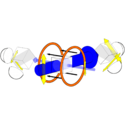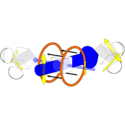Putting the squeeze on many atoms
In quantum mechanics, a squeezed state is characterized by two noncommuting observables, where one observable has a small variance at the expense of a large variance in the other, so that the uncertainty principle is satisfied. There is currently interest in preparing macroscopic squeezed states as this would improve the storage capability of quantum memory devices, such as atomic ensembles that store a state of light that can later be read out optically.
A macroscopic spin state—composed of many individual spins—can be squeezed provided that entanglement can be created within the system. Writing in Physical Review Letters, researchers at the Niels Bohr Institute in Copenhagen report the creation of a spin squeezed state in an ensemble of spin-polarized cesium atoms. They take advantage of entanglement between the nuclear and electronic spin states of the individual ground state atoms, rather than between the electronic spin states of different atoms in the ensemble.
At room temperature, about cesium atoms, each with a total spin of 4, are confined to a glass cell placed in a magnetic field. An applied laser pulse puts about 98% of the atoms into a state maximally polarized along one axis, creating a coherent spin state (a minimum uncertainty state) with macroscopic spin. Another light pulse creates the entanglement necessary to put the ensemble in a squeezed state. A tomographic reconstruction of the final quantum state verified that a collective spin squeezed state was produced. – Sonja Grondalski





